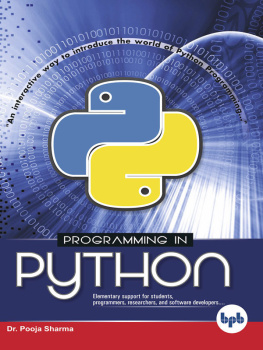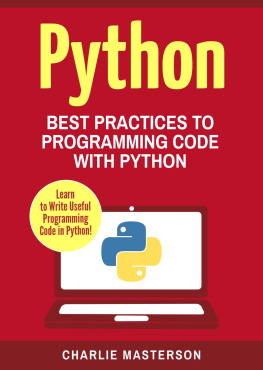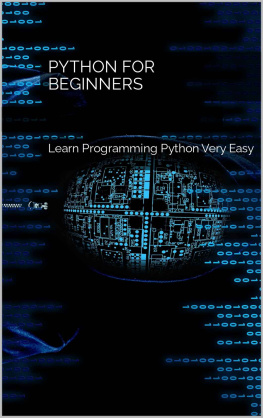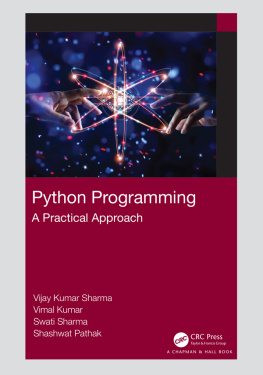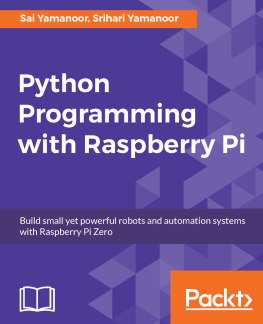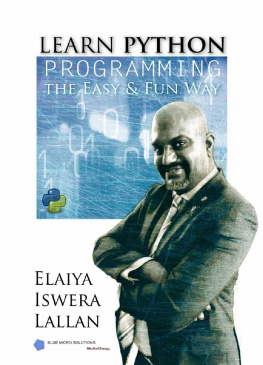Pooja Sharma - Programming in Python
Here you can read online Pooja Sharma - Programming in Python full text of the book (entire story) in english for free. Download pdf and epub, get meaning, cover and reviews about this ebook. year: 2018, publisher: BPB Publications, genre: Home and family. Description of the work, (preface) as well as reviews are available. Best literature library LitArk.com created for fans of good reading and offers a wide selection of genres:
Romance novel
Science fiction
Adventure
Detective
Science
History
Home and family
Prose
Art
Politics
Computer
Non-fiction
Religion
Business
Children
Humor
Choose a favorite category and find really read worthwhile books. Enjoy immersion in the world of imagination, feel the emotions of the characters or learn something new for yourself, make an fascinating discovery.
- Book:Programming in Python
- Author:
- Publisher:BPB Publications
- Genre:
- Year:2018
- Rating:3 / 5
- Favourites:Add to favourites
- Your mark:
- 60
- 1
- 2
- 3
- 4
- 5
Programming in Python: summary, description and annotation
We offer to read an annotation, description, summary or preface (depends on what the author of the book "Programming in Python" wrote himself). If you haven't found the necessary information about the book — write in the comments, we will try to find it.
Programming in Python — read online for free the complete book (whole text) full work
Below is the text of the book, divided by pages. System saving the place of the last page read, allows you to conveniently read the book "Programming in Python" online for free, without having to search again every time where you left off. Put a bookmark, and you can go to the page where you finished reading at any time.
Font size:
Interval:
Bookmark:
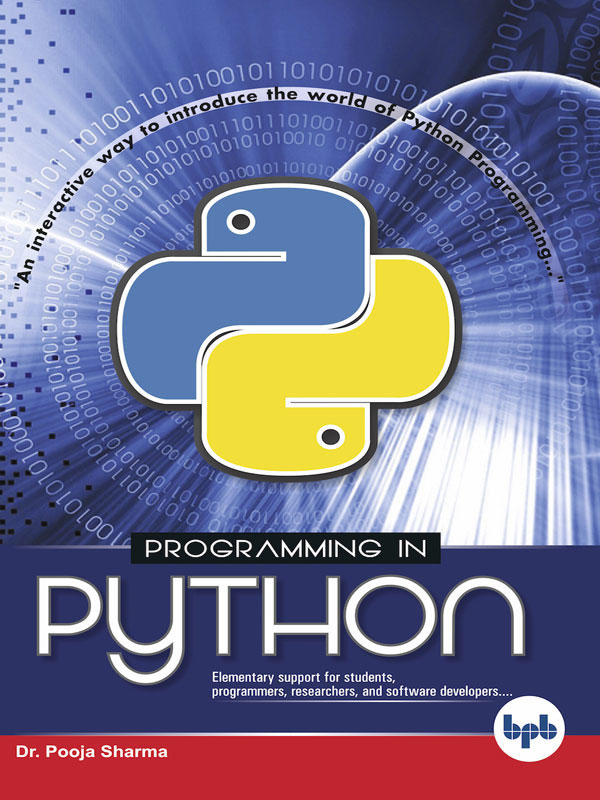

Programming in Python
by
Dr. Pooja Sharma

FIRST EDITION 2020
Copyright BPB Publications, India
ISBN: 978-93-8655-127-6
All Rights Reserved. No part of this publication may be reproduced or distributed in any form or by any means or stored in a database or retrieval system, without the prior written permission of the publisher with the exception to the program listings which may be entered, stored and executed in a computer system, but they can not be reproduced by the means of publication.
LIMITS OF LIABILITY AND DISCLAIMER OF WARRANTY
The information contained in this book is true to correct and the best of authors & publishers knowledge. The author has made every effort to ensure the accuracy of these publications, but cannot be held responsible for any loss or damage arising from any information in this book.
All trademarks referred to in the book are acknowledged as properties of their respective owners.
Distributors:
BPB PUBLICATIONS
20, Ansari Road, Darya Ganj
New Delhi-110002
Ph: 23254990/23254991
MICRO MEDIA
Shop No. 5, Mahendra Chambers,
150 DN Rd. Next to Capital Cinema,
V.T. (C.S.T.) Station, MUMBAI-400 001
Ph: 22078296/22078297
DECCAN AGENCIES
4-3-329, Bank Street,
Hyderabad-500195
Ph: 24756967/24756400
BPB BOOK CENTRE
376 Old Lajpat Rai Market,
Delhi-110006
Ph: 23861747
Published by Manish Jain for BPB Publications, 20 Ansari Road, Darya Ganj, New Delhi-110002 and Printed by him at Repro India Ltd, Mumbai
The Appendix-I is given which provides the list of Python Standard Modules with the description of each.
The bibliography is given at the end for refernece of readers
The author is always indebted and gratified to the almighty for making her capable of writing this book and accomplishing achievements. She conveys her heartiest thanks to the authorities of DAV University, Jalandhar for their cooperation. She is extremely grateful to her parents for their encouragement and support in every sphere of life. She is also thankful to her husband Raj Kumar for his persistent motivation and support throughout writing this book and her little daughter Angel.
The author is thankful to BPB Publications for their assistance and guidance on this book.
Dr. Pooja Sharma
Dr. Pooja Sharma completed her Bachelor Degree in Computer Applications in 2005 with 4th position in the University and Master Degree in Computer Science in 2007 with Gold Medal for securing first position from Guru Nanak Dev University, Amritsar. She did her PhD in 2013 on Content Based Image Retrieval under the supervision of Dr. Chandan Singh from Punjabi University, Patiala. Her academic achievements include fellowship for regular PhD from UGC, New Delhi after qualifying UGC NET and JRF, several merit certificates, gold and silver medals in matric, higher secondary, undergraduate and post graduate levels. She has several research publications in peer reviewed International journals of Springer and Elsevier with significant Thomson Reuters impact factors. She is the reviewer of various International journals of Elsevier, IET (IEEE Computer Society), and Scientific Research and Essays. She has participated in various conferences and workshops. Her areas of specialization include Content Based Image Retrieval, Face Recognition, Pattern Recognitio n, and Digital Image Processing. She worked and selected at various eminent Universities and Colleges during last 10 years including Central University. Presently, she is appointed as Assistant Professor in the Department of Computer Applications, I.K. Gujral Punjab Technical University, Kapurthala.
Introduction and history of Python language
Features of Python
Applications of Python
Python interactive help
Installing and executing Python
How Python differ from other languages
We see that computers are capable of solving numerous problems of the real world. The problems can be as simple as to multiply two numbers or as cumbersome as to design and launch a space shuttle. This would be incorrect to assume that the computer can do all the tasks on its own. Any problem whose solution is not identified cannot be solved by a computer. The computer merely works on the set of instructions given to it by a programmer. If the computer does not understand the instructions then errors may occur and solution cannot be obtained. Therefore, it is keen responsibility of the programmer to devise a solution by giving correct instructions to the computer.
In order to solve a problem using computer, the programmer writes the instructions which are understandable by the computer. The computer understands only digital data either 0 or 1. The most basic language is the machine language that uses binary 0 and 1., which a computer can understand and execute very fast without using any translator (compiler or interpreter). However, it is quite difficult to code a program in machine language. The high level languages such as (C, C++, Java) are very simple to understand by humans because these languages use English language like statements. However, an additional program such as a compiler or interpreter is required to convert the high level language into machine language. Therefore, high level languages are slower than machine languages.
In other words, we can say that people express themselves using a language that has many words. Computers use a simple language that consists of strings of 0s and 1s, with a 1 representing on and a 0 representing off.. The programming language works as a translator between you and the computer. Rather than learning the computer's native language (called as machine language), one can make use of a programming language to instruct the computer in a way that is easier to learn and understand.
Every programming language has a particular structure with a specific syntax and semantics. Programming language is something like a code for writing down the instructions that a computer will follow. In fact, programmers often refer to their programs as computer code, or the process of implementing an algorithm. Alike other high level languages such as C, C++, Java, Python is also a programming language. In this book, we will learn Python programming language in detail.
Python is a very powerful high-level, object oriented programming language. It was developed by Guido Van Rossum during 1985-1990 at the national research institute for mathematics and computer science in Netherlands. It is the derivative of several other languages such as ABC, Modulo-3, C, C++, Algol-68, SmallTalk and Unix Shell. ABC is a general-purpose programming language or programming environment, which had been developed in Netherlands, Amsterdam, at the CWI (Centrum Wiskunde & Informatica). The greatest achievement of ABC was to influence the design of Python.
The source code of Python language is available under GNU i.e., General Public License (GPL). The Python is a very easy to use language with simple syntax, which makes it perfect language for beginners. It is an interpreter based language. Interpreter is a program that converts high level program into low level program, i.e., machine code. It is designed to be highly readable because it uses English keywords very frequently whereas other languages use punctuations. Moreover, it has fewer syntactical constructions than other languages.
Font size:
Interval:
Bookmark:
Similar books «Programming in Python»
Look at similar books to Programming in Python. We have selected literature similar in name and meaning in the hope of providing readers with more options to find new, interesting, not yet read works.
Discussion, reviews of the book Programming in Python and just readers' own opinions. Leave your comments, write what you think about the work, its meaning or the main characters. Specify what exactly you liked and what you didn't like, and why you think so.

